Solubility and Valence Variation of Ce in Low-Alkali Borosilicate Glass and Glass Network Structure Analysis
Abstract
1. Introduction
2. Experiment
2.1. Simulated Waste Glass Preparation
2.2. Characterization
2.3. Anti-Leaching Experiment
3. Results and Discussion
3.1. Physical Phase and Microstructural Analysis
3.2. SEM and EDX Analysis
3.3. Raman Analysis
3.4. Valence Analysis of Ce
3.5. Thermal Stabilization
3.6. Anti-Leaching Features
4. Conclusions
- -
- The solubility of simulated trivalent actinide nucleophile Ce in low-alkali borosilicate glasses is ≥25%, and spherical CeO2 crystalline phases precipitate when the Ce doping exceeds the solid solution limit.
- -
- The Raman results show that the addition of Ce causes glass network depolymerization, and Ce is retained in the glass matrix of low-alkali borosilicate glasses by adsorbing into the gaps in the glass network. Furthermore, Ce causes a shift between [BO3] and [BO4].
- -
- In low-alkali borosilicate glasses, more than 50% of Ce4+ is converted to Ce3+, and the low-alkali borosilicate glass has good thermal stability and resistance to leaching for immobilizing simulated actinide Ce.
Author Contributions
Funding
Institutional Review Board Statement
Informed Consent Statement
Data Availability Statement
Conflicts of Interest
References
- Ping, L.; Hongyi, Y.; Lin, L.; Changzhi, X.; Yuan, L. Development of Nuclear Power in China under Carbon Neutrality Target. J. Energy Conversat. Technol. 2023, 41, 10–15. [Google Scholar] [CrossRef]
- Rodríguez-Penalonga, L.; Soria, B.Y.M. A Review of the Nuclear Fuel Cycle Strategies and the Spent Nuclear Fuel Management Technologies. J. Energy 2017, 10, 1235. [Google Scholar] [CrossRef]
- Caurant, D.; Majérus, O. Glasses and Glass-Ceramics for Nuclear Waste Immobilization. In Encyclopedia of Materials: Technical Ceramics and Glasses; Elsevier: Amsterdam, The Netherlands, 2021; pp. 762–789. [Google Scholar] [CrossRef]
- Gin, S.; Abdelouas, A.; Criscenti, L.J.; Ebert, W.L.; Ferrand, K.; Geisler, T.; Harrison, M.T.; Inagaki, Y.; Mitsui, S.; Mueller, K.T.; et al. An International Initiative on Long-Term Behavior of High-Level Nuclear Waste Glass. J. Mater. Today 2013, 16, 243–248. [Google Scholar] [CrossRef]
- Caurant, D.; Loiseau, P.; Majérus, O.; Aubin-Chevaldonnet, V.; Bardez, I.; Quintas, A. Glasses, Glass-Ceramics and Ceramics for Immobilization of Highly Radioactive Nuclear Wastes; Nova Science Publishers: New York, NY, USA, 2009. [Google Scholar]
- Stefanovsky, S.V.; Shiryaev, A.A.; Zubavitchus, J.V.; Veligjanin, A.A.; Marra, J.C. Valence State and Speciation of Uranium Ions in Borosilicate Glasses with a High Iron and Aluminum Content. J. Glass. Phys. Chem. 2009, 35, 141148. [Google Scholar] [CrossRef]
- Day, D.E.; Wu, Z.; Ray, C.S.; Hrma, P. Chemically Durable Iron Phosphate Glass Wasteforms. J. Non-Cryst. Solids 1998, 241, 1–12. [Google Scholar] [CrossRef]
- Wang, J. On Area-Specific Underground Research Laboratory for Geological Disposal of High-Level Radioactive Waste in China. J. Rock. Mech. Geotech. 2014, 6, 99–104. [Google Scholar] [CrossRef]
- Wang, J. High-Level Radioactive Waste Disposal in China: Update 2010. J. Rock. Mech. Geotech. 2010, 2, 1–11. [Google Scholar] [CrossRef]
- Zhao, X.G.; Zhao, Z.; Guo, Z.; Cai, M.; Li, X.; Li, P.F.; Chen, L.; Wang, J. Influence of Thermal Treatment on the Thermal Conductivity of Beishan Granite. Rock. Mech. Rock. Eng. 2018, 51, 2055–2074. [Google Scholar] [CrossRef]
- Tong, Q.; Liu, S.; Huo, J.; Zhang, X.; Liu, H.; Zheng, K.; Cui, Z.; Zhu, Y. Structure, Crystallization Behavior and Chemical Stability Analysis of Nd3+-Basaltic Glasses for Immobilizing Simulated Trivalent Actinides. J. Nucl. Mater. 2023, 574, 154194. [Google Scholar] [CrossRef]
- Shaydullin, S.M.; Belanova, E.A.; Kozlov, P.V.; Remizov, M.B.; Dvoryanchikova, E.M. Investigation of Borosilicate Glasses with Simulated HLW Components and Determination of Their Chemical Durability. Chem. Techno Acta 2021, 8, 8015. [Google Scholar] [CrossRef]
- Chouard, N.; Caurant, D.; Majérus, O.; Guezi-Hasni, N.; Dussossoy, J.L.; Baddour-Hadjean, R.; Pereira-Ramos, J.P. Thermal Stability of SiO2–B2O3–Al2O3–Na2O–CaO Glasses with High Nd2O3 and MoO3 Concentrations. J. Alloys Compd. 2016, 671, 84–99. [Google Scholar] [CrossRef]
- Icenhower, J.P.; Steefel, C.I. Dissolution Rate of Borosilicate Glass SON68: A Method of Quantification Based upon Interferometry and Implications for Experimental and Natural Weathering Rates of Glass. J. Geochimi. Cosmochim. Acta 2015, 157, 147–163. [Google Scholar] [CrossRef]
- Kidari, A.; Dussossoy, J.L.; Brackx, E.; Caurant, D.; Magnin, M.; Bardez-Giboire, I. Lanthanum and Neodymium Solubility in Simplified SiO2-B2O 3-Na2O-Al2O3-CaO High Level Waste Glass. J. Am. Ceram. Soc. 2012, 95, 2537–2544. [Google Scholar] [CrossRef]
- Li, H.; Wu, L.; Xu, D.; Wang, X.; Teng, Y.; Li, Y. Structure and Chemical Durability of Barium Borosilicate Glass–Ceramics Containing Zirconolite and Titanite Crystalline Phases. J. Nucl. Mater. 2015, 466, 484–490. [Google Scholar] [CrossRef]
- Meng, C.; Ding, X.; Li, W.; Zhao, J.; Yang, H. Phase Structure Evolution and Chemical Durability Studies of Ce-Doped Zirconolite–Pyrochlore Synroc for Radioactive Waste Storage. J. Mater. Sci. 2016, 51, 5207–5215. [Google Scholar] [CrossRef]
- Wang, F.; Wang, Y.; Chen, J.; Liao, Q.; Zhu, H.; Zhou, J.; Qu, X.; Gong, Z.; Fu, X.; Zhu, Y. Effect of Cerium Oxide on Phase Composition, Structure, Thermal Stability and Aqueous Durability of Sodium-Iron-Boron-Phosphate Based Glasses. J. Nucl. Mater. 2021, 556, 153199. [Google Scholar] [CrossRef]
- Yu, H.; Xin, R.; Zhang, X.; Liu, H.; Zheng, K.; Zhao, J.; Zhan, L.; Xu, C.; Wan, W.; Zhu, Y.; et al. Crystallization Behavior, Quantitation of Ce3+/Ce4+ and Chemical Stability Analysis of Multiple Alkaline Earths Borosilicate Glasses for Immobilizing Simulated Tetravalent Actinides. J. Non-Cryst. Solids 2021, 558, 120642. [Google Scholar] [CrossRef]
- Lopez, C.; Deschanels, X.; Bart, J.M.; Boubals, J.M.; Den Auwer, C.; Simoni, E. Solubility of Actinide Surrogates in Nuclear Glasses. J. Nucl. Mater. 2003, 312, 76–80. [Google Scholar] [CrossRef]
- ASTM C1285-21; Standard Test Methods for Determining Chemical Durability of Nuclear, Hazardous, and Mixed Waste Glasses and Multiphase Glass Ceramics: The Product Consistency Test (PCT). ASTM International: West Conshohocken, PA, USA, 2002.
- Corkhill, C.L.; Cassingham, N.J.; Heath, P.G.; Hyatt, N.C. Dissolution of UK high-level waste glass under simulated hyperalkaline conditions of a colocated geological disposal facility. Int. J. Appl. Glass Sci. 2013, 4, 341–356. [Google Scholar] [CrossRef]
- Thorat, V.S.; Mishra, R.K.; Sudarsan, V.; Kumar, A.; Tyagi, A.K.; Kaushik, C.P. Leaching Studies on Borosilicate Glasses for the Immobilization of High-Level Radioactive Waste in the Pellet Form Subjected to Aggressive Test Conditions. J. Bull. Mater. Sci. 2019, 42, 211. [Google Scholar] [CrossRef]
- Yongqi, S.; Zuotai, Z. Structural Roles of Boron and Silicon in the CaO-Si-B2O3 glasses Using FTIR Ramna and NMR Spectroscopy. J. Metall. Mater. Trans. B 2015, 46, 1549–1554. [Google Scholar] [CrossRef]
- Kline, J.; Tangstad, M.; Tranell, G. A Raman Spectroscopic Study of the Structural Modifications. J. Non-Cryst. Solids 2015, 46, 62–73. [Google Scholar] [CrossRef]
- Bechgaard, T.K.; Mauro, J.C.; Bauchy, M.; YuanZheng, Y.; Lamberson, L.A.; Jensen, L.R.; Smedskjaer, M.M. Fragility and Configurational Heat Capacity of Calcium Aluminosilicate. J. Non-Cryst. Solids 2017, 461, 24–34. [Google Scholar] [CrossRef]
- Iguchi, Y.; Kashio, S.; Goto, T.; Nishina, Y.; Fuwa, T. Raman Spectroscopic Study on the Structure of Silicate Glass. J. Can. Metall. Quart. 1981, 20, 51–56. [Google Scholar] [CrossRef]
- Tong, Q.; Liu, S.; Huo, J.; Zhang, X.; Zhu, Y.; Zhang, A. Structure and Stability Analysis of Basaltic Glasses for Immobilizing Simulated Actinides Nd, Ce and La. J. Non-Cryst. Solids 2023, 600, 122043. [Google Scholar] [CrossRef]
- Angeli, F.; Villain, O.; Schuller, S.; Charpentier, T.; de Ligny, D.; Bressel, L.; Wondraczek, L. Effect of Temperature and Thermal History on Borosilicate Glass Structure. Phys. Rev. B 2012, 85, 054110. [Google Scholar] [CrossRef]
- El-Damrawi, G.; El-Egili, K. Characterization of novel CeO2-B2O3 glasses, structure and properties. Phys. B Condens. Matter. 2001, 299, 180–186. [Google Scholar] [CrossRef]
- Dantas, N.O.; Ayta, W.E.F.; Silva, A.C.A.; Cano, N.F.; Silva, S.W.; Morais, P.C. Effect of Fe2O3 Concentration on the Structure of the SiO2–Na2O–Al2O3–B2O3 Glass System. Spectrochin. Acta A 2011, 81, 140–143. [Google Scholar] [CrossRef]
- Fabian, M.; Gergely, F.; Osan, J.; Cendak, T.; Kesari, S.; Rao, R. Structural Investigation of Borosilicate Glasses Containing Lanthanide Ions. Sci. Rep. 2020, 10, 7835. [Google Scholar] [CrossRef]
- Caurant, D.; Majérus, O.; Fadel, E.; Quintas, A.; Gervais, C.; Charpentier, T.; Neuville, D. Structural Investigations of Borosilicate Glasses Containing MoO3 by MAS NMR and Raman Spectroscopies. J. Nucl. Mater. 2010, 396, 94–101. [Google Scholar] [CrossRef]
- Zhang, K.; Luo, B.; Zhang, H. Immobilization of CeO 2 Using Single-Phase Zirconolite and the Chemical Stability Analysis. Mater. Res. Express 2019, 6, 115526. [Google Scholar] [CrossRef]
- Dawkins, K.; Rudyk, B.W.; Xu, Z.; Cadien, K. The PH-Dependant Attachment of Ceria Nanoparticles to Silica Using Surface Analytical Techniques. Appl. Surf. Sci. 2015, 345, 249–255. [Google Scholar] [CrossRef]
- Gin, S.; Jollivet, P.; Tribet, M.; Peuget, S.; Schuller, S. Radionuclides Containment in Nuclear Glasses: An Overview. Radiochim. Acta 2017, 105, 927–959. [Google Scholar] [CrossRef]
- Tan, P.; Shu, X.; Wen, M.; Li, L.; Lu, Y.; Lu, X.; Chen, S.; Dong, F. Characteristics of Cerium Doped Aluminosilicate Glass as Simulated Radioactive Waste Forms: Effect on Structures and Properties. Prog. Nucl. Energ. 2022, 150, 104299. [Google Scholar] [CrossRef]
- Prakash, A.D.; Singh, M.; Mishra, R.K.; Valsala, T.P.; Tyagi, A.K.; Sarkar, A.; Kaushik, C.P. Studies on Modified Borosilicate Glass for Enhancement of Solubility of Molybdenum. J. Non-Cryst. Solids 2019, 510, 172–178. [Google Scholar] [CrossRef]
- Xu, C.; Huo, J.; Zhang, X.; Huo, Y.L.; Zhu, Y. Study on the Solubility, Structure and Chemical Durability of Molybdenum in Diopside Glass. Glass 2022, 49, 7–12. [Google Scholar] [CrossRef]
- EJ 1186-2005; Characterization of Radioactive Waste Forms and Packages. Nuclear Industry Standard in China, Commission for Science, Technology and Industry for National Defense: Beijing, China, 2005.
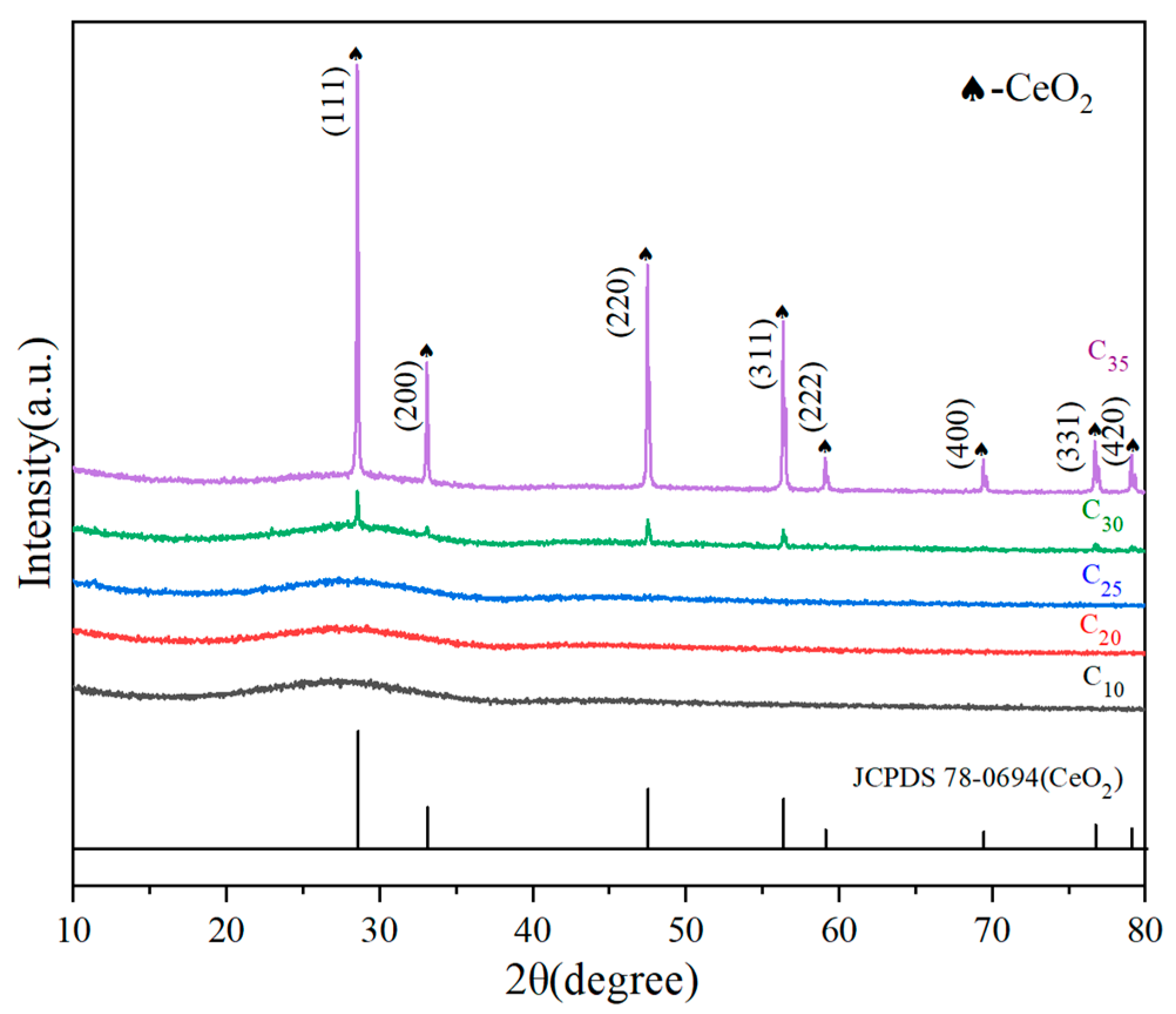
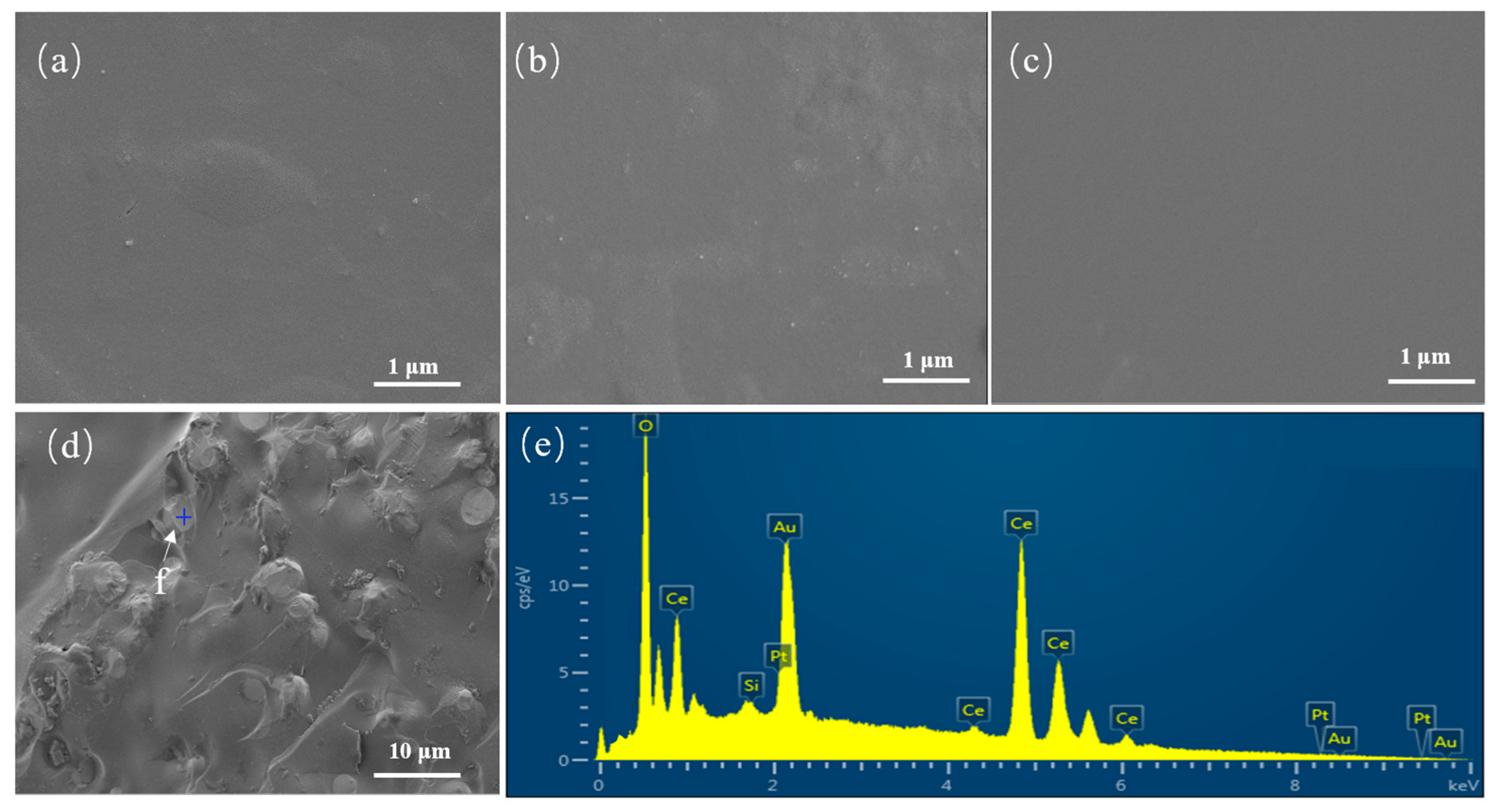
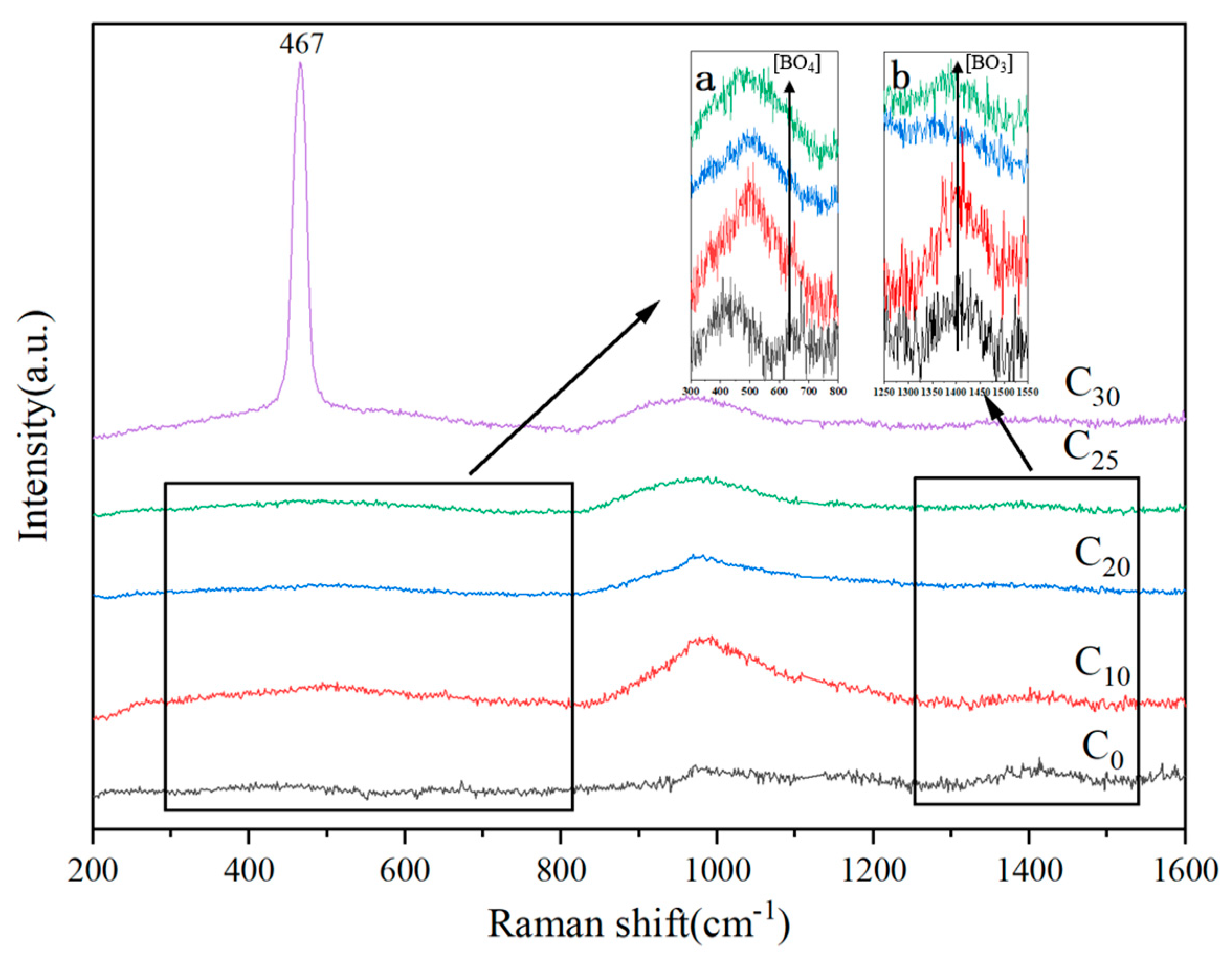
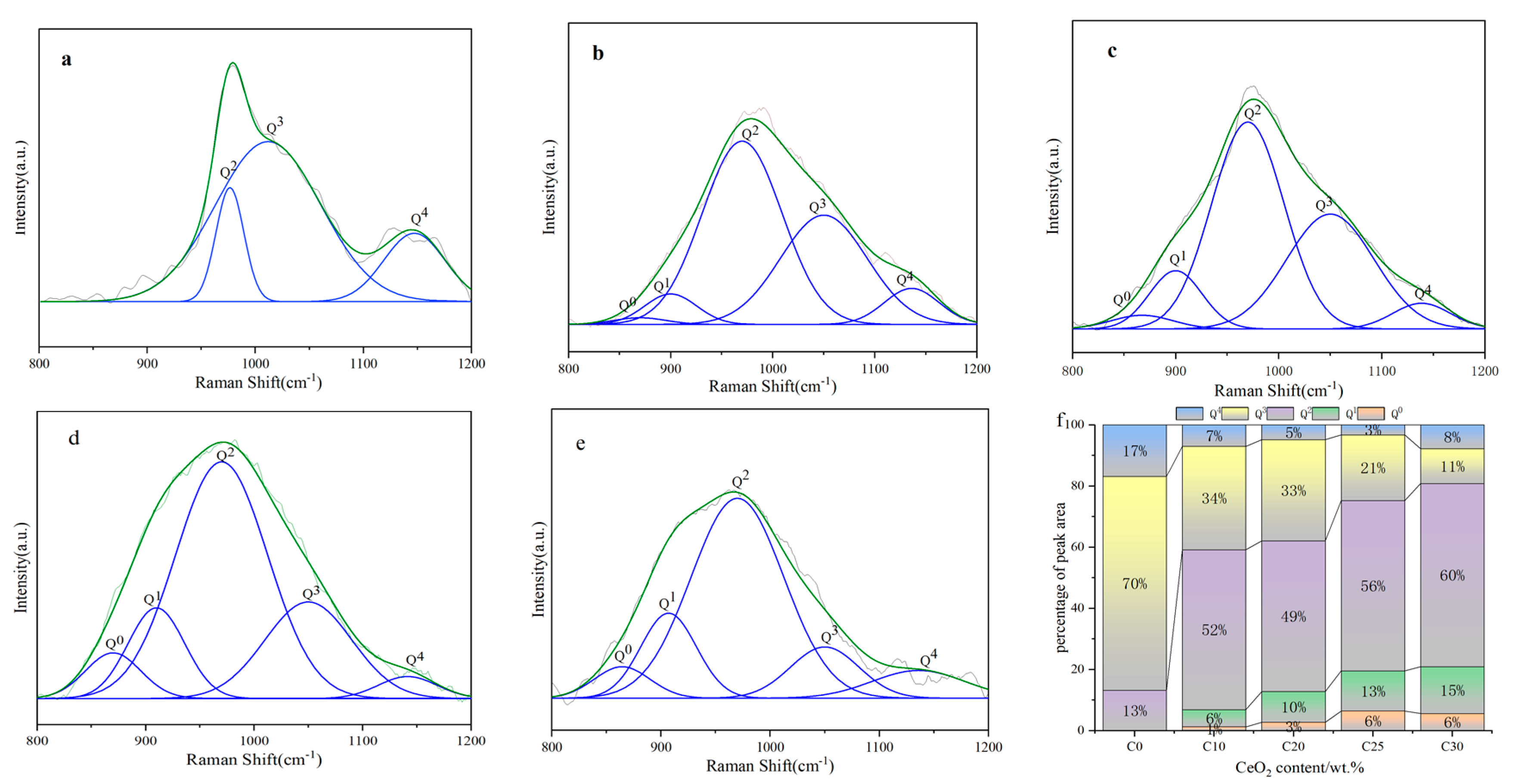

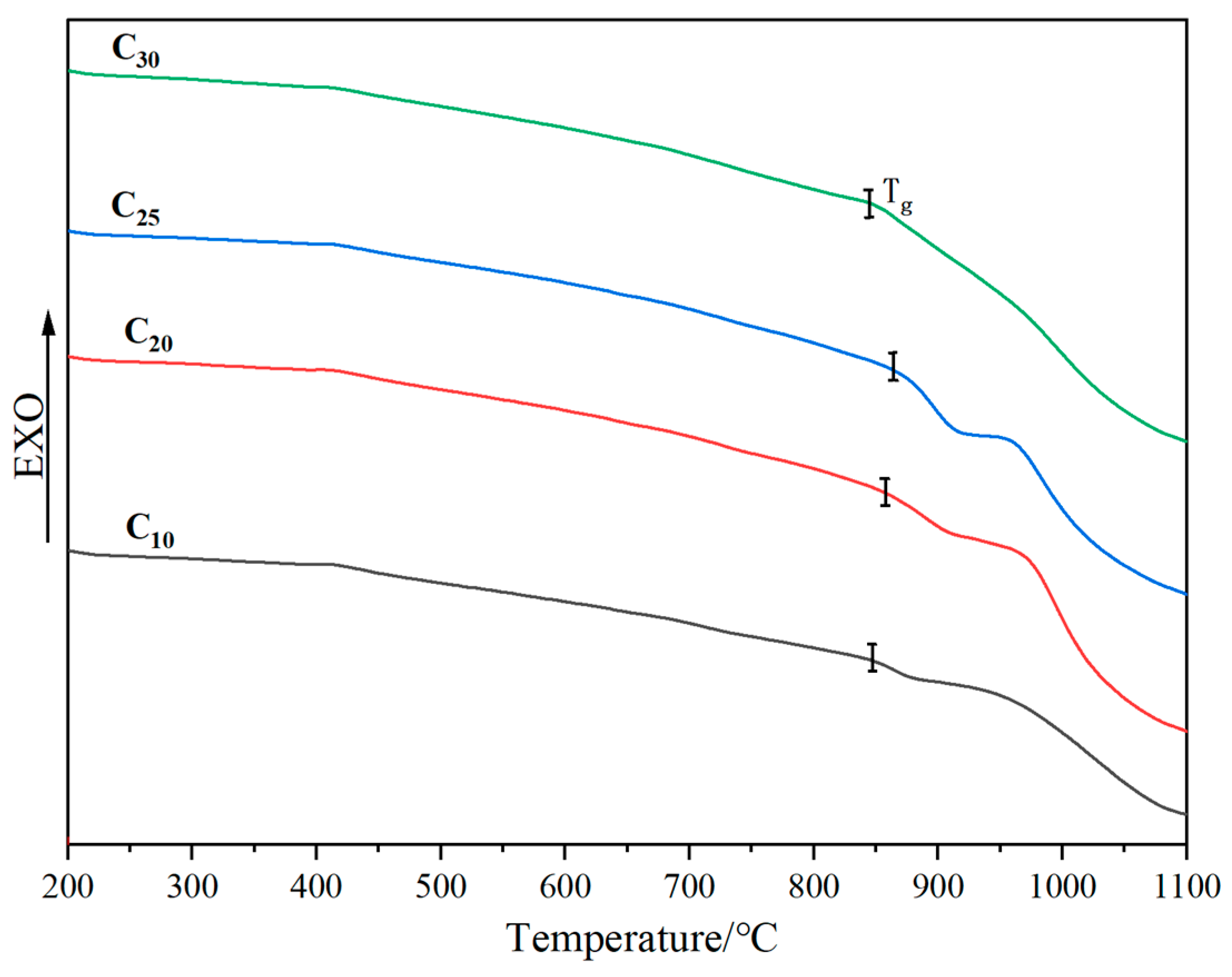

| Components | SiO2 | Al2O3 | B2O3 | CaO | MgO | Fe2O3 | FeO | TiO2 | K2O | Na2O |
|---|---|---|---|---|---|---|---|---|---|---|
| Mass fraction(%) | 54.43 | 14.41 | 6.57 | 22.57 | 0.64 | 0.34 | 0.12 | 0.33 | 0.23 | 0.36 |
| Sample | C10 | Area | C20 | Area | C25 | Area | C30 | Area |
|---|---|---|---|---|---|---|---|---|
| u1′ | 900.33 | 11,761.62 | 900.28 | 19,172.5 | 900.19 | 23,900.06 | 900.54 | 20,066.49 |
| u1 | 881.92 | 15,709.68 | 881.86 | 25,657.34 | 881.8 | 33,547.52 | 881.83 | 26,054.39 |
| u0′ | 905.41 | 13,709.63 | 904.76 | 24,776.7 | 905.11 | 26,859.23 | 905.42 | 20,155.53 |
| u0 | 886.68 | 19,682.76 | 886.55 | 32,886.86 | 886.44 | 41,498.19 | 886.41 | 35,150.47 |
| v0′ | 903.05 | 12,777.1 | 902.58 | 12,789.6 | 902.92 | 23,148.48 | 903.29 | 20,306.55 |
| v1′ | 908.15 | 5146.83 | 907.39 | 10,236.81 | 907.78 | 9193.86 | 907.97 | 6999.5 |
| v2′ | 918.72 | 2246.95 | 917.46 | 2967.11 | 917.65 | 5282.2 | 917.41 | 3978.63 |
| v0 | 884.49 | 16,176.4 | 884.34 | 25,356.57 | 884.29 | 30,577.06 | 884.17 | 25,644.03 |
| v1 | 889.19 | 4481 | 888.95 | 6740.43 | 917.65 | 5282.2 | 888.7 | 8711.89 |
| v2 | 897.14 | 2162.72 | 896.98 | 2960.69 | 897.08 | 2863.49 | 898.31 | 4887.07 |
| A | 1.42 | 1.68 | 1.65 | 1.44 | ||||
| B | 0.59 | 0.63 | 0.62 | 0.59 |
Disclaimer/Publisher’s Note: The statements, opinions and data contained in all publications are solely those of the individual author(s) and contributor(s) and not of MDPI and/or the editor(s). MDPI and/or the editor(s) disclaim responsibility for any injury to people or property resulting from any ideas, methods, instructions or products referred to in the content. |
© 2023 by the authors. Licensee MDPI, Basel, Switzerland. This article is an open access article distributed under the terms and conditions of the Creative Commons Attribution (CC BY) license (https://creativecommons.org/licenses/by/4.0/).
Share and Cite
Yang, L.; Zhu, Y.; Huo, J.; Cui, Z.; Zhang, X.; Dong, X.; Feng, J. Solubility and Valence Variation of Ce in Low-Alkali Borosilicate Glass and Glass Network Structure Analysis. Materials 2023, 16, 5063. https://doi.org/10.3390/ma16145063
Yang L, Zhu Y, Huo J, Cui Z, Zhang X, Dong X, Feng J. Solubility and Valence Variation of Ce in Low-Alkali Borosilicate Glass and Glass Network Structure Analysis. Materials. 2023; 16(14):5063. https://doi.org/10.3390/ma16145063
Chicago/Turabian StyleYang, Liu, Yongchang Zhu, Jichuan Huo, Zhu Cui, Xingquan Zhang, Xuanjiang Dong, and Jie Feng. 2023. "Solubility and Valence Variation of Ce in Low-Alkali Borosilicate Glass and Glass Network Structure Analysis" Materials 16, no. 14: 5063. https://doi.org/10.3390/ma16145063
APA StyleYang, L., Zhu, Y., Huo, J., Cui, Z., Zhang, X., Dong, X., & Feng, J. (2023). Solubility and Valence Variation of Ce in Low-Alkali Borosilicate Glass and Glass Network Structure Analysis. Materials, 16(14), 5063. https://doi.org/10.3390/ma16145063





